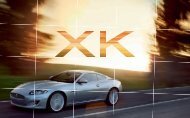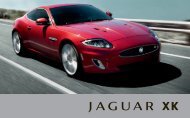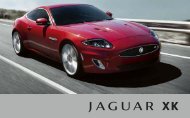Create successful ePaper yourself
Turn your PDF publications into a flip-book with our unique Google optimized e-Paper software.
GLOSSARY<br />
POWERTRAIN AND DRIVING DYNAMICS<br />
JAGUAR SEQUENTIAL SHIFT TM<br />
Provides the choice of Drive, Sport Automatic or Manual gearshift modes, with one-touch paddles mounted<br />
behind the steering wheel to control gear changes up and down manually.<br />
JAGUARDRIVE CONTROL TM<br />
Interacts with the DSC (Dynamic Stability Control) engine and transmission management systems to change<br />
the characteristics of engine mapping, transmission shifts and brake interventions. It offers different modes<br />
including Winter and Dynamic modes, selectable by buttons to optimize the vehicle response depending on<br />
driving conditions and style.<br />
WINTER MODE<br />
Softens the responsiveness of the engine and modifies the gear change strategy to help maintain optimum<br />
traction in slippery or adverse conditions. When active, Winter Mode also selects 2nd gear for pulling<br />
away on level ground (no incline). Dials and graphic details change in the Virtual Instruments when Winter<br />
Mode is selected.<br />
DYNAMIC MODE<br />
Optimizes vehicle systems to deliver a more involving driving experience. When selected, engine torque<br />
delivery characteristics and gear shift points are modified to further improve responsiveness. When selected<br />
while the transmission is in full manual mode, transmission up-shifts are fully controlled by the driver, with no<br />
automatic up-shift when the rev limit is reached. Dials and graphic details change in the Virtual Instruments<br />
when Dynamic Mode is selected.<br />
ADAPTIVE DYNAMICS (1)<br />
Provides the optimum balance between low speed ride comfort and high speed handling precision,<br />
analyses body movement, steering and road wheel inputs up to 500 times a second and continuously<br />
adjusts the suspension settings through electronically controlled dampers.<br />
ACTIVE DIFFERENTIAL (1)<br />
An electronically controlled, active differential with Handling Functionality that limits the slip between<br />
the rear wheels to optimize traction and stability in different driving conditions, working in harmony with<br />
the Traction, ABS and DSC systems.<br />
CRUISE CONTROL WITH AUTOMATIC SPEED LIMITER (ASL) (1)<br />
In tandem with cruise control, an Automatic Speed Limiter (ASL) allows the driver to select a maximum<br />
speed not to be exceeded.<br />
ADAPTIVE CRUISE CONTROL (ACC) (1)<br />
Uses microwave radar technology to monitor for slower moving traffic and can alert the driver to potential<br />
hazards ahead. It also controls both throttle and brakes to help maintain a constant time gap to the vehicle in<br />
front. Forward Alert provides an audible warning if traffic ahead slows.<br />
ADVANCED EMERGENCY BRAKE ASSIST (1)<br />
An enhancement to the ACC function. Using the ACC radar, the system calculates distance and speed of<br />
approach to the vehicle in front and pre-charges the brakes to help minimise impact speed if a collision<br />
is anticipated.<br />
DYNAMIC STABILITY CONTROL (DSC) (1)<br />
Intervenes in demanding driving situations by applying braking to individual wheels and reducing engine torque.<br />
TRAC DSC MODE<br />
Provides a higher intervention threshold for the more skilled driver.<br />
EXTERIOR FEATURES<br />
ADAPTIVE FRONT LIGHTING (1)<br />
Sensors react to the car’s speed and steering input; the system can deflect headlamp beams casting light<br />
deeper into corners, and giving added confidence at night. Intelligent High Beam will automatically switch the<br />
headlamps to high beam. When sensing preceding, oncoming traffic or street lights, the headlamps will<br />
automatically switch to low beam, maximizing driver visibility and appropriate beam usage.<br />
BLIND SPOT MONITOR (1)<br />
Uses radar sensors to remotely monitor areas that cannot be seen either directly or by mirror, and alerts the<br />
driver of overtaking traffic with an amber warning icon in the external mirrors.<br />
FRONT parking aid (1)<br />
Sensors are designed to detect obstacles in the front of the car and alerts the driver with both audible signal<br />
and visual display on the Touch-screen.<br />
REVERSE PARK CAMERA with guidance & REAR PARKING AID (1)<br />
Combines a rear-facing camera with the Touch-screen information, it features coloured distance guides<br />
and on-screen guidance lines that move according to steering wheel angle to indicate the area into which<br />
the car will reverse. The rear parking aid uses ultrasonic sensors mounted in the bumper and is designed to<br />
detect objects and provide an audible alert as well as a display on the centre console Touch-screen.<br />
70
















